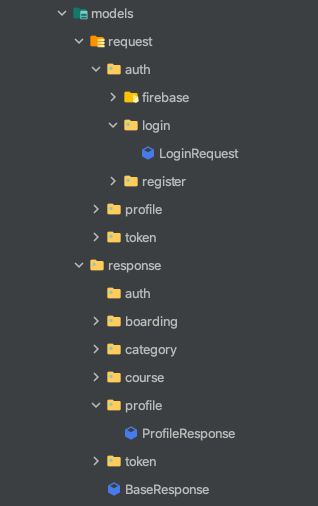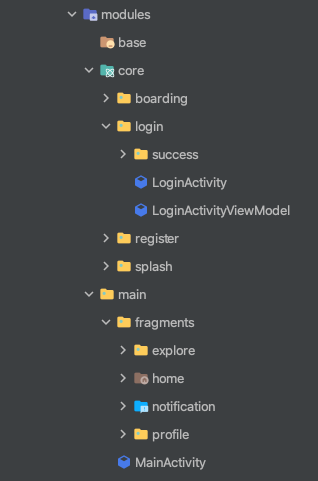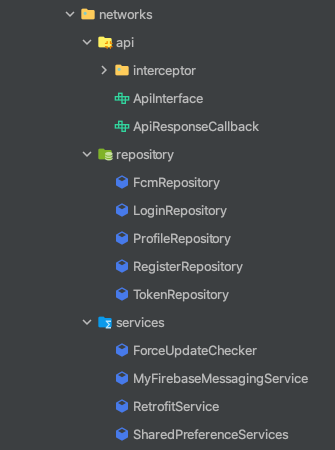MVVM
The Layers of MVVM
The code is divided into three separate layers:
- Presentation Layer
- Domain Layer
- Data Layer
We’ll get into more detail about each layer below. For now, our resulting package structure looks like this:
- Models

- Modules

- Networks

The Presentation Layer
This includes our Activities, Fragments, and ViewModels. An Activity should be as dumb as possible. Never put your business logic in Activities.
An Activity will talk to a ViewModel and a ViewModel will talk to the domain layer to perform actions. A ViewModel never talks to the data layer directly.
Here’s how code looks:
Activity Class
class LoginActivity : AppCompatActivity() {
//Data Binding
private lateinit var binding: ActivityLoginBinding
//View Model
private lateinit var viewModel: LoginActivityViewModel
override fun onCreate(savedInstanceState: Bundle?) {
super.onCreate(savedInstanceState)
binding = ActivityLoginBinding.inflate(layoutInflater)
setContentView(binding.root)
initVar()
initObserver()
}
private fun initVar() {
viewModel = ViewModelProvider(this)[LoginActivityViewModel::class.java]
progressDialog = Helpers.getProgressDialog(this)!!
}
private fun initObserver() {
viewModel.isLoading.observe(this) { isLoading ->
/// TODO Do your action here
}
viewModel.errorMessage.observe(this) { message ->
/// TODO Do your action here
}
viewModel.loginResponseMutableLiveData.observe(this) { response ->
/// TODO Do your action here
}
}
}ViewModel Class
class LoginActivityViewModel(application: Application) : AndroidViewModel(application) {
//Repository
private var loginRepository: LoginRepository = LoginRepository()
//Object
var loginResponseMutableLiveData: MutableLiveData<ProfileResponse> = MutableLiveData()
//ETC
var isLoading: MutableLiveData<Boolean> = MutableLiveData()
var errorMessage: MutableLiveData<String> = MutableLiveData()
fun postLogin(email: String, password: String) {
when {
email.isEmpty() -> {
errorMessage.value = "Email cannot be empty"
}
password.isEmpty() -> {
errorMessage.value = "Passwowrd cannot be empty"
}
else -> {
val body = LoginRequest(
email = email,
password = password,
)
isLoading.value = true
loginRepository.postLogin(
body,
SharedPreferenceServices.getToken(getApplication()),
object : ApiResponseCallback<ProfileResponse?> {
override fun onSuccess(response: ProfileResponse?) {
isLoading.value = false
loginResponseMutableLiveData.value = response
errorMessage.value = null
}
override fun onFailure(error: String?) {
isLoading.value = false
loginResponseMutableLiveData.value = null
errorMessage.value = error
}
})
}
}
}
}
The Domain Layer
The domain layer contains all the use cases of your application.
In this example, we have:
RetrofitService, an class forHTTP Request.class RetrofitService {
companion object {
private val NETWORK_TIMEOUT = 600
fun getRetrofitInstance(context: Context?): Retrofit? {
val builder = GsonBuilder()
val gson = builder
.setLenient()
.create()
val retrofit: Retrofit.Builder = Retrofit.Builder()
.baseUrl(BuildConfig.BASE_URL_APP)
.addConverterFactory(GsonConverterFactory.create(gson))
.addCallAdapterFactory(RxJava2CallAdapterFactory.create())
val httpClient: OkHttpClient.Builder =
OkHttpClient.Builder()
.addInterceptor(Interceptor { chain: Interceptor.Chain ->
val original = chain.request()
val request =
original.newBuilder()
.method(original.method, original.body)
.build()
chain.proceed(request)
})
.connectTimeout(NETWORK_TIMEOUT.toLong(), TimeUnit.SECONDS)
.readTimeout(NETWORK_TIMEOUT.toLong(), TimeUnit.SECONDS)
.writeTimeout(NETWORK_TIMEOUT.toLong(), TimeUnit.SECONDS)
//Add Logging Interceptor
if (BuildConfig.DEBUG) {
val logging = HttpLoggingInterceptor()
logging.setLevel(HttpLoggingInterceptor.Level.BODY)
httpClient.addInterceptor(logging)
}
retrofit.client(httpClient.build())
return retrofit.build()
}
}
}ApiResponseCallback, an interface class for callback.interface ApiResponseCallback<in TData> {
fun onSuccess(response: TData?)
fun onFailure(error: String?)
}The purpose of the
ApiResponseCallbackis to be a mediator for response from API between yourViewModelsandRepositories.ApiInterface, an interface class for call the API endpoints.interface ApiInterface {
@POST(value = "/authorization/handheld/login")
fun postLogin(
@Body body: LoginRequest
): Observable<BaseResponse<ProfileResponse>>
}The purpose of the
ApiInterfaceis to be a mediator for call API between yourViewModelsandRepositories.Singleton, an class for communicate betweenRepositoryandHTTP Requestclass Singleton {
companion object {
@SuppressLint("StaticFieldLeak")
private lateinit var context: Context
fun setContext(con: Context) {
context = con
}
private fun getApplicationContext(): Context {
return context
}
fun getService(): ApiInterface? {
return RetrofitService.getRetrofitInstance(getApplicationContext())
?.create(ApiInterface::class.java)
}
}
}
The Data Layer
This has all the repositories which the domain layer can use. This layer exposes a data source API to outside classes:
class LoginRepository {
private val compositeDisposable = CompositeDisposable()
fun postLogin(
body: LoginRequest,
token: String,
callback: ApiResponseCallback<ProfileResponse?>
) {
Singleton.getService(token)?.postLogin(body)
?.observeOn(AndroidSchedulers.mainThread())
?.subscribeOn(Schedulers.io())?.let {
compositeDisposable.add(
it
.subscribe({ response -> callback.onSuccess(response.data) }) { error ->
callback.onFailure(
Helpers.onFailed(error)
)
})
}
}
}
Source Toptal - Abhishek Tyagi